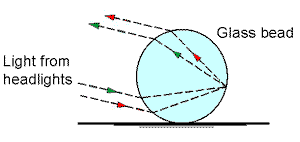| |
| |
|
| |
| |
| |
||
| |
||
| |
||
|
|
|
Painting A Highway
When you are travelling down a road in a vehicle, the lengths of the pavement marking segments appear shorter than they really are due to the combined effects of viewing them at an angle and viewing them while travelling at speed. Ask someone that has stood beside a highway while hitchhiking about this - they've probably noticed that these paint segments are surprisingly long. Believe it or not, pavement markings such as these "lane lines" as well as crosswalks and stop-bars at intersections are not just placed on a roadway at someone's whim but are actually designed according to numerous rules, regulations and guidelines established by various agencies. Here in British Columbia, Canada for instance, these include;
On a historical note, did you know that the use of paint lines such as these was pioneered by a Canadian in 1930?
Did you also know that reflective highway pavement markings
actually contain a layer of very tiny glass beads? Civil Technologists are involved in the design of road and highway systems and are responsible for interpreting and applying regulations and guidelines to ensure that a safe and easy to use facility is designed and constructed. In addition to the proper use of pavement markings, roadway designers also ensure that similar regulations and guidelines are observed for the installation of traffic signs for every driver's safety, guidance, information and regulation. You may not have thought about it before, but every inch (or centimeter) of highway and street that you travel on has been designed in detail by someone - that someone could be you. If so, we're willing to help you get on the road to your new career... |

 The
answer then to how long are the paint dashes? Lengths are shown
in the figure at left for most rural and urban roads in B.C. The colour
of the paint is important too. In North America the colour yellow is
used to separate traffic travelling in opposite directions and also
used on the left edge of divided highways and one-way roadways. White
lane lines are used to separate traffic flowing in the same direction
and white edge lines are used to mark the outside edge of a right lane.
The
answer then to how long are the paint dashes? Lengths are shown
in the figure at left for most rural and urban roads in B.C. The colour
of the paint is important too. In North America the colour yellow is
used to separate traffic travelling in opposite directions and also
used on the left edge of divided highways and one-way roadways. White
lane lines are used to separate traffic flowing in the same direction
and white edge lines are used to mark the outside edge of a right lane. The truck that applies pavement markings first sprays down the required
colour of paint at the appropriate location through a nozzle and then
a second nozzle follows immediately behind and applies a very thin layer
of glass beads that sticks to the wet paint. When light from vehicle
headlights hits this layer of glass beads, it is reflected internally
through each bead and then back to the driver of the vehicle.
The truck that applies pavement markings first sprays down the required
colour of paint at the appropriate location through a nozzle and then
a second nozzle follows immediately behind and applies a very thin layer
of glass beads that sticks to the wet paint. When light from vehicle
headlights hits this layer of glass beads, it is reflected internally
through each bead and then back to the driver of the vehicle.